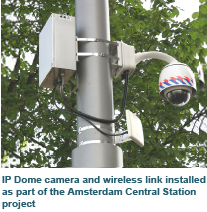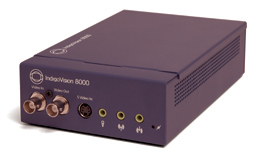Oliver Vellacott, CEO of IndigoVision and Ronan Smith, CEO of Wavesight discuss the many advantages that wireless technology brings to IP Video Solutions
In the last decade there has been a massive growth in the use of license-exempt radio technology to carry data, voice and video across networks, moving away from the traditional cable route.
Inside many organizations, wireless technology is being deployed as extensions to traditional wired infrastructures - e.g. wireless access points connected to the existing network, where cabling would be too costly. Externally, wireless Ethernet bridging is being used to extend networks across buildings several Kilometres apart.
Increasingly, this technology is being seen as highly complementary to IP Video and the two are often rolled out together.
Ease of deployment
The rapid deployment of wireless is a major benefit, from a time and cost perspective:
- It's often the most cost-effective way to get data from A to B because it substantially reduces the cost of laying cable and/or using leased lines from various carriers.
- By using license-exempt radio there are no delays and costs involved in obtaining licences or by-law approvals for laying cable.
- The capital outlay on hardware - radios and antennas - is significantly less to buy and deploy.
- With minimal operating costs once deployed; the reality of lower cost per Megabyte transmitted and ROI (return on investment) is quickly realised.
- With less cable to install, project timeframes are significantly reduced and business disruption is minimised.
IP video - exploiting wireless technology
IP video is used to describe the transmission, control and recording of live digital CCTV images over IP based networks. A typical system would include multiple cameras connected to an IP network via transmitter/receiver modules; video and alarm management software controlling the viewing, analysis and recording of the digital video from each camera and finally networked video recorders (NVRs) providing the system-wide recording facilities.

The key component in an analog CCTV system is the matrix. In an IP Video system, the network and the software controlling it become the so-called ‘virtual matrix'. IP Video systems operate over standard corporate networks. As these typically span entire organizations, so can the IP Video systems connected to them. As the traditional control room equipment can be replaced by a PC it is possible, and often desirable, to monitor live and recorded video from any camera from any point on the network.
Each camera is connected to the network via a transmitter/receiver unit that compresses the analog video into DVD quality MPEG-4 digital video for transmission over the network. The transmitter/receiver units allow any type of CCTV camera to be connected to the network, ensuring existing equipment can be used when migrating to an IP video solution. However, for new installations one option is an IP camera or dome. These combine a professional full-function high-quality CCTV color camera with an IP video transmitter/receiver in one unit, which can be connected directly to the network. Significant cost savings can be achieved by employing the integrated camera units in place of traditional analog video cameras and a separate IP transmitter/receiver unit. When using a wireless link, the camera, the IP transmitter/receiver module and the wireless components can easily be packaged within a small footprint, only requiring a local power connection.
It soon becomes apparent that an IP network based solution for CCTV surveillance that removes the costly and inflexible analog matrix, is an extremely cost-effective and scalable system. To add another camera to the system in the future simply requires a connection to a point anywhere on the network. The Athens Olympics in 2004 used an IP backbone for the security system. The system encompassed over 2000 cameras across 47 venues in an area of 250 km. These were accessible from 63 command centers with 1250 operators. This type of enterprise system could not have been implemented with a traditional analog system.
Increased flexibility
The advantages of IP Video for large enterprise systems is compelling, with its underlying flexibility and scalability. However, it is also an ideal solution for smaller CCTV systems and in particular for upgrades to existing installations. When upgrading from an existing analog system the obsolete equipment such as the matrix and DVRs can be replaced, but all the cameras, domes, monitors and keyboards can be kept. Using IP transmitter/receiver units, all existing cameras and monitors can be interconnected. In fact existing control room configurations can largely remain unchanged. With the addition of a PC or two, all the advanced features of IP CCTV can be made available without the need to change the familiar surroundings of the control room. Once the migration is complete it is very easy to expand the system in the future. It is now becoming common practice for IP video systems to be used to expand existing analog CCTV systems based on cost alone - it is often just too costly to cable in new cameras from remote locations. When combined with wireless solutions the distance of remote locations can be significantly increased, further enhancing the advantages of wireless IP Video systems.

As well as increased range, using a wireless infrastructure provides additional flexibility. Existing cameras can be easily relocated - ideal for temporary or tactical deployments - and multiple wired LANs, each accommodating IP Video equipment, could be easily connected together wirelessly to create one seamless IP Video network offering greater coverage and control.
The flexibility and scalability of IP Video is therefore well placed to exploit the benefits of wireless technology. Whether the IP Video system is based on a totally wire-free network or more commonly is extended using Ethernet bridging, the two technologies are very complementary.
Increased performance
Based on the current 802.11 a/b/g wireless standards, bridging systems can now reliably deliver upwards of 54 Mbps or even 108 Mbps in turbo mode - comparable with many traditional networks and capable of handling the bandwidth requirements of IP video systems.
From March 2006 onwards, a new development of the standard 802.11n, will enable up to 6 times the throughput. This will accommodate digital video from the next generation of high-resolution cameras.
In terms of range, external point-to-point and multipoint links can now extend to over 40 kilometers. Whereas at one time a clear line of sight was required, increasing use of new technologies including OFDM (a system that helps transmission devices benefit from reflected radio waves) readily permits near or in some cases no-line of sight capability.
Transmission security
Often perceived as less secure than wired links, wireless transmission security has matured. For example typical wireless systems now incorporate advanced encryption technologies. These include 128bit AES (as used by the US Government to handle its own classified data), TKIP (randomly generating one of 500 trillion keys for each packet of data sent) and 152-bit WEP and RADIUS (digital signature authentication) - making it very difficult, if not impossible for a would-be intruder to break into the Wi-Fi element of any network. Additionally anyone trying to ‘eavesdrop' on a radio transmission is simply unable to decipher what they hear.
Manageability

One of the key benefits of IP-enabled security is the ability to remotely monitor and manage cameras and other systems throughout the network. Many organizations use this capability to devolve the responsibility for these tasks, easing resource issues.
To support this, the latest wireless transmission systems also carry remote management capability, such as Simple Network Management Protocol (SNMP), giving network administrators the ability to identify the source and type of anomaly, e.g. power downs, low signal level etc.
In the context of IP video systems, the message is clear - organizations now have the ability to cost effectively deploy surveillance solutions across their network and beyond, with all the speed, security and ease of management they need.



















